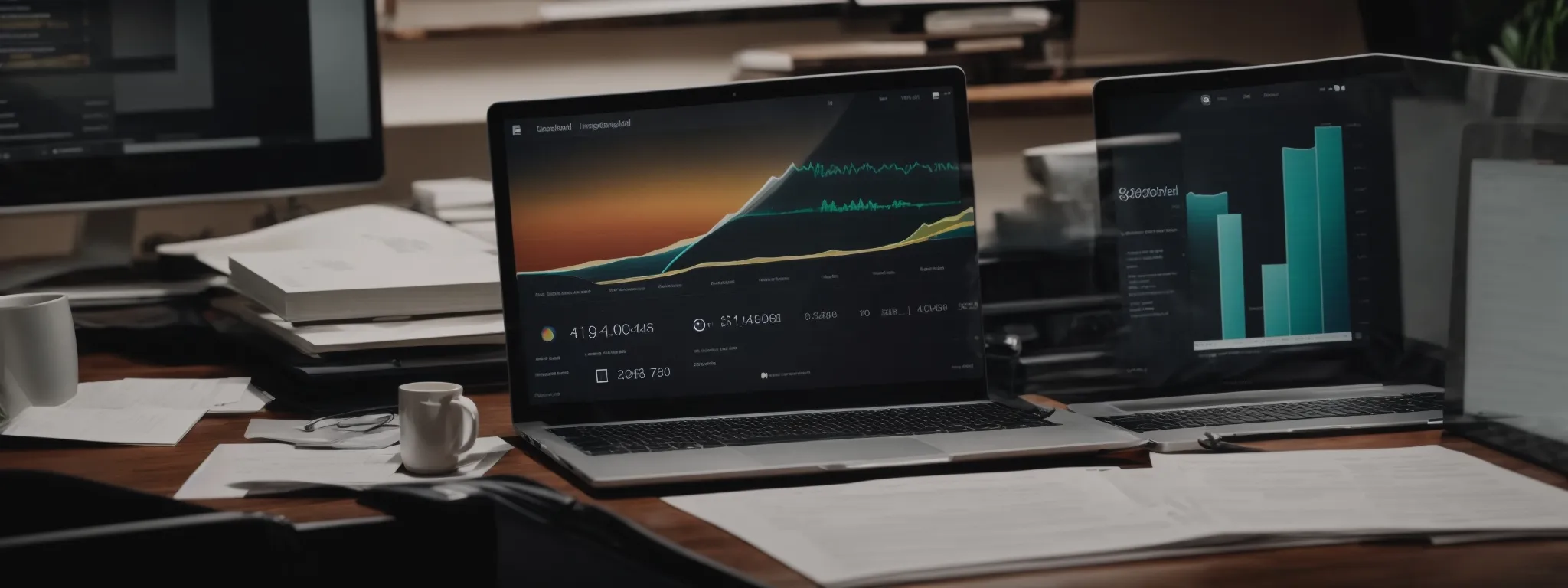SEO Do’s and Don’ts: Avoid These Mistakes
SEO Best Practices: Key Mistakes to Avoid In the ever-evolving terrain of digital marketing, mastering search engine optimization is akin to a commander strategizing a winning battle […]
SEO Best Practices: Key Mistakes to Avoid
In the ever-evolving terrain of digital marketing, mastering search engine optimization is akin to a commander strategizing a winning battle plan.
Ignoring elements such as site speed and keyword relevance can lead to a plummet in search engine rankings, just as a ship hitting an iceberg in the vast SEO ocean.
However, companies like LinkGraph rise above these challenges, ensuring their clients’ digital presence is as robust and searchable as possible through comprehensive SEO services, like those offered by Search Atlas.
Keep reading to discover pivotal SEO practices and pitfalls that could mean the difference between obscurity and ranking dominance.
Key Takeaways
- Site Speed Is a Crucial SEO Factor That Affects User Experience and Search Rankings
- Comprehensive Keyword Research Is Essential to Align With User Intent and Increase Conversion Potential
- LinkGraph’s Strategies Focus on Both Acquiring Quality Backlinks and Avoiding Black-Hat Tactics
- Mobile Optimization Is Critical for SEO Due to the Prevalence of Mobile Device Usage
- Regular Analytics Monitoring Is Key to Refining SEO Strategies and Improving Content Engagement and Conversion Rates
Recognize the Impact of Page Speed on SEO

In the realm of SEO best practices, site speed stands as a pivotal aspect often overlooked by company stakeholders and webmasters alike.
As search engines continually refine their algorithms to prioritize user experience, the loading times of web pages have become a critical ranking factor affecting a site’s search engine position.
Site owners embarking on the SEO journey with LinkGraph must recognize that a sluggish page can turn away visitors, increase bounce rates and erode search rankings.
To sidestep these pitfalls, LinkGraph suggests employing a strategic approach encompassing a thorough Backlink Analysis, image optimization, effective browser caching, and the streamlining of code.
Each of these components is integral to solidifying the SEO groundwork that sustains website visitor engagement and conversion.
Identify Speed Issues With Tools
LinkGraph equips site owners with the necessary tools to identify and address site speed issues. Search Atlas features a suite of analytic measures, among which is site speed analysis that meticulously charts loading times across multiple devices and browsers.
Following an insightful SEO Audit, actionable data empowers clients to tackle speed-related obstacles head-on: reducing redirect chains that delay page loading, optimizing images that burden bandwidth, and adjusting server response times for peak performance. This data forms the backbone for informed decisions and strategic refinement in SEO efforts:
- An analysis of redirect chains and their impact on site speed
- Optimization techniques for images to lighten site load
- Evaluation of server response times with recommendations for improvement
Optimize Images for Faster Loading
Optimizing images emerges as a non-negotiable step for bolstering page speed, a decisive element of LinkGraph’s SEO suite. Large, high-resolution images often cause extended load times, compelling site owners to embrace compression techniques that strike a balance between visual quality and file size to enhance the user experience without sacrificing aesthetic appeal.
LinkGraph’s approach integrates advanced tools within Search Atlas that effectively automate image optimization, performing tasks from resizing to format selection, ensuring web pages load swiftly. This vital practice not only improves site speed but also contributes significantly to a website’s overall SEO strategy, affirming its position in search engine rankings.
Leverage Browser Caching for Efficiency
Leveraging browser caching emerges as a pivotal technique within the SEO best practice repertoire offered by LinkGraph. By enabling this functionality, returning visitors experience markedly faster loading times, as their browsers cache a significant portion of the site’s resources, diminishing server load and subsequent wait times.
Search Atlas, LinkGraph’s comprehensive SEO tool, aids clients in implementing optimal caching parameters, ensuring that static resources like stylesheets, images, and JavaScript files are stored efficiently. This aspect of technical SEO stands as a silent but formidable contributor to a site’s overall user experience and search engine ranking.
Minimize JavaScript and CSS Files
Minimizing JavaScript and CSS files is an intricate part of LinkGraph’s approach to refining webpage performance. Expansive and unoptimized code can bog down page load times, directly impacting the user’s gateway to accessing content promptly.
- Condensing JavaScript files to remove unnecessary characters
- Merging multiple CSS files to reduce HTTP requests
- Utilizing minification techniques to streamline code efficiency
LinkGraph employs innovative strategies to consolidate and minify these elements, thus enhancing the loading efficiency of web pages. This move aligns with SEO best practices, reducing server load and accelerating the display of content to the searcher.
Choose Relevant Keywords for Effective SEO

Embarking on an SEO adventure starts with identifying the most impactful search terms pertinent to one’s target audience.
LinkGraph emphasizes the importance of keyword research as a cornerstone of any robust SEO strategy.
By arming oneself with an array of relevant and carefully chosen keywords, businesses position their web pages to attract meaningful search traffic.
LinkGraph’s experts caution website owners against common pitfalls such as keyword stuffing, which can negatively affect search ranking, and instead recommend a strategy that includes an assortment of long-tail keywords designed to capture the search intent of their audience.
By favoring precision over volume in keyword selection, site owners can attain a competitive edge in search engine results pages.
Conduct Thorough Keyword Research
LinkGraph asserts that meticulous keyword research is foundational to crafting a high-performing SEO strategy. The company’s professionals harness the power of Search Atlas to scrutinize search term relevancy, delving into the nuances of audience queries to pinpoint terms that resonate with user intent and promise high conversion potential.
The focus on granular detail during the keyword research phase is crucial, as it steers site owners away from the common seo mistake of generic keyword targeting. LinkGraph advises on the pursuit of terms that not only reflect the searcher’s intent but also align with the company’s product or service offerings, bridging the gap between visitor expectations and the value a website provides.
Focus on Long-Tail Keywords for Better Targeting
LinkGraph champions the pragmatic use of long-tail keywords in any Content Strategy, delivering a cutting-edge approach that transcends basic search term selection. These extensive keywords, which are often more descriptive and specific, tend to mirror the sophisticated searches conducted by users who are further along in the buyer’s journey and closer to a conversion point.
For webmasters and small businesses, the integration of long-tail keywords translates to a more targeted audience and less competition on the search results landscape. With LinkGraph’s expertise, clients can effectively permeate niche markets and enhance their digital marketing strategy, as this methodology is tailored to meet the nuanced needs of a refined customer base:
| SEO Component | Benefits of Long-Tail Keywords | LinkGraph Solutions |
|---|---|---|
| Search Intent Alignment | Matches specific user queries | Search Atlas keyword research tools |
| Competition Levels | Lower than short-tail keywords | Lesser-dense keyword targeting |
| Conversion Potential | Higher due to specificity | Content strategies focused on user needs |
Avoid Keyword Stuffing in Content Creation
LinkGraph’s seasoned professionals emphasize the detrimental impact of keyword stuffing on content creation, warning site owners that this outdated tactic not only dilutes the message but can also invite penalties from search engines. Their expert advice underscores the principle that content should flow naturally, with keywords woven seamlessly into the text to enhance relevance and search ranking without sacrificing the reader’s trust and engagement.
Staying clear of excessive repetition of search terms, LinkGraph’s strategy focuses on creating meaningful content that addresses users’ needs while maintaining keyword density at optimal levels. This disciplined approach strikes a harmonious balance between SEO and user experience, bolstering the integrity of the web page and elevating its stance in the eyes of both the search engine and the visitor.
Encourage Engagement and Site Visits Properly

In the digital arena, the symbiotic relationship between SEO and user engagement remains a cornerstone of expanding online visibility.
Site visits and customer interaction hinge on strategic measures that go beyond mere search engine rankings.
Companies like LinkGraph underscore the importance of leveraging social platforms to bolster traffic, actively engaging website visitors through thoughtful comment threads, and devising compelling calls-to-action that resonate with reader intent.
These elements converge to create a dynamic online presence that captivates the target audience, encourages repeat visits, and fosters community around a brand.
Use Social Media to Drive Traffic
LinkGraph acknowledges the influential role of social media in amplifying a website’s reach and driving targeted traffic back to the main digital hub. By strategically curating and sharing content across various social platforms, businesses can tap into their audience’s daily online habits and create additional pathways for users to discover and connect with their brand.
Effective social media outreach, guided by LinkGraph’s digital marketing strategy, bolsters a brand’s online ecosystem, seamlessly integrating social engagement with the website’s content, thus enhancing visibility and funneling a broader, yet more targeted, customer base towards the company’s digital offerings.
Engage With Your Audience Through Comments
LinkGraph’s approach to bolstering user engagement extends to the artful management of comment sections—digital arenas where audience participation can thrive. The company delineates a clear strategy: prompt responses to user comments create a sense of community, making each visitor feel heard and valued, and augmenting the likelihood of their return visits and further interaction with the content.
Furthermore, LinkGraph underscores the significance of monitoring comment sections for insights and feedback. Such engagement not only enhances the user experience by displaying responsiveness but also offers invaluable data points that can inform and refine the overarching SEO and content strategy, ultimately contributing to a stronger foothold in SERPs (Search Engine Results Pages).
Create Compelling Calls-to-Action
LinkGraph understands the power of a well-crafted call-to-action (CTA) in transforming passive readers into active participants, customers, or subscribers. CTAs serve as the guiding beacon for site visitors, ushering them towards a desired action, whether it be subscribing to a newsletter, downloading a whitepaper, or making a purchase.
The art of creating compelling CTAs lies in the subtle balance of urgency and benefit, a craft that LinkGraph has mastered, encouraging visitor conversion without coming across as forceful. These pivotal prompts, strategically positioned within blog posts or landing pages, are crafted to resonate with the underlying search intent, effectively leading users to the next phase of engagement:
| SEO Element | Role of CTA | LinkGraph’s Approach |
|---|---|---|
| Blog Posts | Facilitates deeper exploration of content | Integration of contextually relevant CTAs |
| Landing Pages | Converts visitors into leads or customers | Optimization of CTA placement and messaging |
| User Experience | Enhances the journey towards conversion | Alignment of CTAs with user goals and expectations |
Prioritize High-Quality Content for Better Ranking

Boosting a website’s search engine ranking transcends the mere aggregation of keywords and backlinks; it is rooted profoundly in the quality of content one presents to their audience.
LinkGraph, a beacon in the search engine optimization space, propels its clients towards recognition on search engine results pages through the strategic crafting of content that transcends superficial appeal.
Expertly aligning with user intent, adhering to a consistent content publication calendar, and revitalizing dated content are fundamental practices within LinkGraph’s arsenal, each serving to engage visitors meaningfully and carve out a digital presence that’s both authoritative and relevant.
Understand User Intent for Content Relevance
LinkGraph’s expertise in aligning content with user intent is a testament to the company’s commitment to delivering search engine optimization that resonates with the user’s needs and search queries. Recognizing the complexity behind why individuals turn to search engines, their specialists dissect the search terms to ensure the content addresses the underlying questions, thereby elevating relevance and bolstering rankings.
This finely-tuned understanding of search intent informs the development of content that not only satisfies the searcher’s queries but also positions LinkGraph’s clients as the go-to source for information, solutions, or products. Content crafted in this manner is more likely to capture the audience’s interest, retain their attention, and, ultimately, influence their interactions with the site, transforming visits into meaningful engagement.
Maintain a Consistent Posting Schedule
A regular cadence of content publication is a signal of reliability and freshness to both search engines and users who frequent a site. LinkGraph actively encourages its clients to maintain this practice, as it facilitates sustained engagement and improves search engine ranking by consistently providing new material for Googlebot and other crawlers to index.
Moreover, LinkGraph supports its clients by integrating strategic planning into their content calendars, ensuring that the publication schedule aligns with the brand’s goals and the audience’s expectations. This proactive approach enables businesses to stay ahead of trends, cater to the informational needs of their visitors, and strengthen their digital footprint in an ever-competitive market.
Update Old Content to Keep It Fresh
In the quest for digital prominence, revitalizing old content is a pivotal move. LinkGraph understands that outdated information can tarnish a website’s credibility and dampen its search engine appeal.
- Assess existing content for timeliness and accuracy.
- Identify opportunities where updates can enhance relevance.
- Implement revisions that reflect the latest industry trends and data.
By infusing fresh data and perspectives into existing pages, the company ensures that its clients’ websites remain competitive and resourceful. This reinforces the site’s stature in the eyes of search engines and users, fostering a perception of authority and reliability.
Enhance User Retention With Engaging Experiences

As businesses delve into the intricate world of search engine optimization, a common oversight that can unravel even the most polished SEO strategy is neglecting user retention.
Increased search rankings may lead potential customers to a page, but it is the calibre of the onsite experience that determines whether these visitors become a part of a company’s customer base.
Effective user retention hinges on three critical features: optimized website navigation that enables users to find information with ease, the judicious incorporation of multimedia elements that engage without overwhelming, and the improvement of website aesthetics to foster a welcoming environment that lowers bounce rates.
LinkGraph champions these focal points, acknowledging that the retention of users is as crucial as their initial acquisition, and thus integrating them into the comprehensive SEO efforts for their clients.
Optimize Website Navigation for Ease of Use
Heightened user retention starts with navigation that is intuitive and straightforward. LinkGraph’s focus on structuring websites with clear, logically arranged menus and categories ensures that users find the information they seek swiftly, significantly ameliorating the user experience and underpinning successful SEO outcomes.
The agency tailors navigation optimization to the neural paths of website visitors, capitalizing on Search Atlas tools to analyze user behavior and adjust navigational elements accordingly. This meticulous attention to website architecture eliminates confusion, reduces friction points, and leads visitors through a seamless journey, bolstering the likelihood of their prolonged engagement with the site.
Incorporate Multimedia Elements Judiciously
When aiming to captivate the target audience, LinkGraph underscores the importance of integrating multimedia elements with a discerning eye. The strategic placement of videos, infographics, and interactive media can significantly enhance user engagement, breaking the monotony of text and delivering information in dynamic ways that resonate with diverse user preferences.
However, LinkGraph cautions against the excessive use of such elements as they can detract from page performance, potentially leading to slower load times and diminished user experience. The agency’s balanced approach ensures multimedia content is both enriching and optimized, supporting SEO efforts by providing value without compromising site speed or accessibility.
Improve Website Aesthetics to Reduce Bounce Rate
LinkGraph understands that the visual appeal of a website plays a significant role in reducing bounce rates and keeping visitors engaged. By designing aesthetically pleasing layouts with coherent color schemes, intuitive interfaces, and readable fonts, they ensure that user retention is positively influenced through inviting website aesthetics.
Attention to detail in design elements substantiates the professionalism and credibility of a site, compelling users to stay and explore:
- Consistent use of colors that align with brand identity and enhance readability.
- Streamlined interfaces that facilitate effortless user journeys.
- Selection of fonts that balance aesthetic appeal with legibility.
The adept team at LinkGraph crafts websites that embrace these principles, balancing form and function to decrease bounce rates effectively and optimize the overall user experience.
Take Mobile Optimization Seriously for SEO

In today’s interconnected landscape, optimizing for mobile devices is not just a recommendation but a cornerstone of any competent SEO strategy.
As increasing numbers of users reach for smartphones and tablets to fulfill their search needs, the ability of a website to adapt and function seamlessly on various devices has become pivotal.
LinkGraph anchors its SEO efforts on a mobile-friendly foundation, understanding that websites must pass rigorous mobile usability tests to please both users and search engines.
Attention to mobile page speed, responsive design, and device compatibility not only enhances the user experience but also contributes to a website’s search engine ranking in profound ways.
Ensure Website Design Is Mobile-Friendly
LinkGraph recognizes the imperative of adopting a mobile-friendly website design, ensuring that elements such as navigation, content layout, and interactive features transition smoothly across all device types. This proactive approach in responsive design not only caters to the growing demographic of mobile users but also aligns with Google’s mobile-first indexing, thereby reinforcing a site’s visibility and search engine ranking.
With the adept use of Search Atlas tools, LinkGraph meticulously optimizes the mobile version of a website, scrutinizing factors like touch screen readiness and readability on smaller screens to offer a seamless user experience. Such dedication to mobile optimization signifies LinkGraph’s commitment to helping clients prevail in a landscape where mobile usability can make or break a website’s search engine success.
Test Site Regularly on Multiple Devices
LinkGraph underscores the importance of regular testing across multiple devices to ensure all visitors receive the same high-quality experience, regardless of their choice of technology. This rigorous testing regime is critical in maintaining a positive user experience, which is a key component of a successful SEO strategy.
Conducting comprehensive device compatibility checks, LinkGraph ensures that business websites perform flawlessly for every user, reflecting a commitment to excellence that search engines and customers alike favor. Meticulous attention to detail in this process underscores the necessity for businesses to adapt to the diverse and ever-evolving landscape of digital devices.
Prioritize Mobile Page Speed Optimization
LinkGraph’s rigorous SEO strategy places considerable emphasis on the optimization of mobile page speed, recognizing its paramount importance in search rankings. Mobile users demand quick load times, and sites that deliver responsiveness benefit from higher engagement levels and favorable search engine treatment.
With a comprehensive approach that streamlines mobile responsiveness, LinkGraph employs cutting-edge Search Atlas tools to analyze and enhance mobile site speed, ensuring their clients’ websites are primed for the swift delivery of content to users on the go.
Avoid Common on-Page SEO Errors to Stay Ahead

Embarking on the path of search engine optimization necessitates a vigilant approach to on-page techniques, where even the smallest oversight can sabotage a well-strategized SEO effort.
Among the multitude of factors affecting a site’s search engine rankings, three pivotal considerations demand expert attention: the crafting of distinct meta descriptions tailored to individual pages, the meticulous identification and repair of broken links that hamper user experience, and the proper application of header tags for optimal content structure.
LinkGraph’s SEO services stand ready to guide businesses through these often-misunderstood elements, ensuring they avoid such common pitfalls that could impede their climb atop search results.
Use Unique Meta Descriptions for Each Page
Meta descriptions serve as concise summaries on the search engine results page, offering searchers a snapshot of what to expect on the respective web page. LinkGraph advises their clients that each page should feature a unique meta description, naturally incorporating the target keyword while ensuring it is compelling enough to encourage click-through. This specificity is essential as it helps to differentiate each page, providing clear value propositions that align with the searcher’s intent.
LinkGraph’s SEO experts stress the importance of avoiding duplication in meta descriptions, as repetitive snippets can cause search engines to perceive content as unoriginal, potentially harming search engine rankings. Instead, they craft customized meta descriptions that accurately reflect the content of each page, enhancing the user experience and contributing to a higher click-through rate which is a key element toward SEO success.
Fix Broken Links to Improve User Experience
LinkGraph emphasizes the importance of meticulously monitoring and repairing broken links within a website, as these can create dead-ends for users, disrupting the navigational flow and potentially diminishing the quality of the user experience. Broken links not only lead to frustration for the visitor but can also signal to search engines a lack of site maintenance, adversely affecting search engine optimization efforts.
Attention to detail in addressing broken links ensures that visitors can seamlessly access content, which in turn sustains their engagement and conveys a message of reliability and professionalism from the business. LinkGraph’s commitment to comprehensive on-page SEO includes the diligent rectification of any such issues:
| SEO Element | Issue | LinkGraph Solution |
|---|---|---|
| Broken Links | Disruptive to user navigation and engagement | Regular site audits and prompt link repair strategies |
| Search Engine Perception | Poor maintenance signals decreasing SEO ranking potential | Ensuring all site links are functional and up-to-date |
| Visitor Retention | Potential drop-off due to navigational issues | Optimized link structure to facilitate user journey continuity |
Correct Improper Use of Header Tags
Header tags play a critical role in organizing content and enhancing the readability of a web page. LinkGraph’s skilled team ensures the appropriate use of H1 through H6 tags, emphasizing the need for a structured hierarchy that aids search engines in understanding the content’s priorities and themes.
Missteps in header tag application, such as skipping levels or non-sequential ordering, can confuse search engines and dilute the SEO strength of a page. With LinkGraph’s guidance, clients learn to deploy header tags correctly, amplifying both user experience and the page’s search engine optimization potential.
Focus on Building Trustworthy Backlinks

In the intricate tapestry of search engine optimization, the art of cultivating trustworthy backlinks cannot be understated.
As companies navigate the complexities of bolstering their online presence, LinkGraph stands at the forefront, guiding clients through the strategic acquisition of backlinks from high-authority domains.
Their suite of SEO tools aids in the vigilant monitoring of backlink profiles, ensuring practices align with the ever-important SEO best practices while steadfastly avoiding the chasm of black-hat tactics.
Through diligent identification and analysis, LinkGraph enables businesses to not only expand their digital footprint but also secure lasting credibility and trust in the competitive realm of search rankings.
Identify High-Authority Domains for Backlinks
LinkGraph’s adept approach to backlink acquisition hinges on the recognition of high-authority domains, acknowledging that the value of a backlink is intrinsically tied to the credibility of the linking website. This discerning method involves rigorous analysis with tools like Search Atlas, which assess domain strength and relevance to ensure that each link reinforces the SEO position of the client’s website.
Securing backlinks from esteemed domains not only heightens a website’s authority in the eyes of search engines but also drives referral traffic from sources that are likely to generate higher conversion rates. The strategic pursuit of such high-quality backlinks forms a cornerstone of LinkGraph’s sophisticated link-building campaigns:
| SEO Process | Backlink Quality Consideration | LinkGraph’s Advantage |
|---|---|---|
| Authority Assessment | Domain authority and content relevancy | Search Atlas’s comprehensive domain analysis |
| Link Profile Enhancement | Strategic acquisition of authoritative links | White Label Link Building and Backlink Analysis services |
Avoid the Pitfalls of Black-Hat Link-Building Practices
LinkGraph astutely steers clients clear of black-hat link-building practices that can jeopardize a site’s integrity and ranking on search engines. Techniques such as link farms, hidden links, or overly aggressive link exchanges are flagged and discarded, ensuring a white-hat approach that builds credibility and sustained SEO success.
Part of LinkGraph’s expertise lies in educating clients on the importance of ethical backlink strategies, recognizing that a strong, reputable link profile is a non-negotiable component of true SEO progression. The company’s vigilance guards against short-lived gains that could result in long-term penalties, solidifying a foundation of trust and authority in the digital space.
Monitor Your Backlink Profile Using SEO Tools
Monitoring a backlink profile is a sophisticated endeavor that LinkGraph simplifies with its state-of-the-art SEO tools. The ongoing supervision of inbound links through Search Atlas allows site owners to observe the strength and relevance of their backlink profiles, ensuring alignment with SEO best practices and identifying any links that may harm their search engine reputation.
Through diligent use of these tools, LinkGraph offers businesses peace of mind, safeguarding against detrimental links and providing insights on how to cultivate a more robust link profile. Regular backlink audits lead to informed strategic decisions, bolstering the site’s standing and authority:
| SEO Task | Objective | LinkGraph Advantage |
|---|---|---|
| Backlink Audits | Analysis of link quality and profile health | Comprehensive insights with Search Atlas tools |
| Link Profile Optimization | Strengthening and purging link profile | Strategic advice and remediation tactics |
Utilize Analytics to Refine SEO Strategies

The strategic application of analytics stands as the compass by which astute digital marketers and SEO specialists navigate the vast and ever-changing landscape of search engine optimization.
With meticulous attention to data-driven insights, businesses can illuminate the efficacy of their online strategies, pinpointing precisely where adjustments may be necessary.
Monitoring bounce rates provides a critical lens into content quality, while tracking conversion rates unfurls the narrative of a website’s effectiveness.
Assessing keyword rankings is equally pivotal, offering a roadmap for continual improvements.
Each element synergistically shapes the refinement of SEO strategies, propelling businesses towards achieving their digital marketing milestones with precision and agility.
Monitor Bounce Rates to Enhance Content Quality
LinkGraph employs bounce rate analytics as a barometer for content engagement, interpreting spikes as indicators of potential issues in content quality or relevance. By analyzing these metrics, they adeptly pinpoint areas for content enhancement, fine-tuning their approach to hold readers’ interest and reduce website exits.
Optimizing the user journey becomes a concerted effort once bounce rate data is collected and analyzed: LinkGraph tailors content to meet user expectations more closely, fostering an environment where visitors find value and relevance, compelling them to stay longer and explore deeper:
| Analytics Aspect | Content Quality Impact | LinkGraph Implementation |
|---|---|---|
| Bounce Rate Analysis | Indicates level of user engagement | Strategic adjustments to content and design |
| User Journey Mapping | Addresses navigational pain points | Enhanced content placement to improve flow |
Track Conversion Rates for Insight on Effectiveness
LinkGraph leverages the power of conversion rate analysis to shed light on a website’s proficiency in turning visitors into customers. By meticulously monitoring this metric, they are able to discern the effectiveness of calls-to-action, on-page elements, and user pathways in driving desired actions.
- Assessment of calls-to-action to ensure they prompt user response
- Examination of on-page elements for their contribution to conversions
- Analysis of user pathways for optimization opportunities
Such insight, when allied with LinkGraph’s SEO mastery, provides a clear direction for iterative enhancements. Clients can thus hone their SEO strategies to not only attract traffic but also to significantly improve conversion rates, bridging the gap between visitors and valuable customers.
Review Keyword Rankings for Adjustments and Improvements
Assiduous oversight of keyword rankings forms a pivotal component in the continuous refinement of an SEO strategy. LinkGraph recognizes the profound impact that shifts in search rankings can have on an online presence, advising clients on the necessity of frequent keyword performance reviews to ensure that ongoing optimization efforts yield positive outcomes.
Adaptability in response to keyword fluctuation is not only prudent but indispensable for maintaining competitive edge in search results. LinkGraph’s commitment to this dynamic process involves the identification of trends and patterns that inform tactical adjustments, elevating the precision of targeting and content relevancy:
- Systematic tracking of keyword performance to detect ranking changes
- Gauging the efficacy of current keyword strategies against measurable goals
- Implementing strategic modifications to improve alignment with searcher intent
Frequently Asked Questions
How does page speed impact SEO and what can be done to optimize it?
Page speed significantly impacts SEO as it affects user experience, influencing bounce rate and subsequently, search engine rankings. To optimize it, businesses can compress images, leverage browser caching, and minimize JavaScript and CSS, ensuring faster loading times for their web pages.
How important is keyword selection in improving search engine rankings?
Keyword selection remains a cornerstone in boosting search engine rankings, with the choice of the right target keywords setting the stage for a website’s visibility and traffic. By aligning content with the specific terms and phrases that searchers use, site owners can significantly improve their chances of appearing prominently on search engine results pages.
What are the effective ways to encourage user engagement and increase site visits?
Engaging users and scaling site traffic hinges on crafting a compelling content strategy alongside optimizing each web page for user experience and search engine visibility. Implementing tactics such as utilizing Search Atlas for comprehensive backlink analysis and deploying LinkGraph’s One-Page SEO Services can significantly enhance visitors’ engagement and inspire recurrent visits.
Why is high-quality content crucial for achieving better search engine ranking?
High-quality content is pivotal for search engine rankings as it satisfies searcher intent, which search engines reward with higher visibility. Moreover, engaging, well-researched content encourages backlinks and shares, factors that search engines consider evidence of value, thus improving a site’s authority and ranking potential.
How can mobile optimization contribute to SEO success and why is it important?
Mobile optimization is an indispensable component of SEO success as it improves user experience for the growing majority who browse on handheld devices. Recognizing the significance of this trend, search engines reward mobile-friendly sites with higher rankings in search results, thereby underlining its importance for businesses aiming to enhance their visibility and attract a mobile-centric customer base.
Conclusion
In conclusion, adhering to SEO best practices is essential for improving search rankings and avoiding common mistakes that can undermine efforts.
Ensuring fast page loading times, using relevant keywords, and engaging with audiences effectively all contribute to a robust SEO strategy.
Optimizing images, leveraging browser caching, and refining JavaScript and CSS files enhance the site’s speed and user experience.
Employing long-tail keywords, avoiding keyword stuffing, and creating compelling content are vital for targeting and retaining users.
Additionally, prioritizing mobile optimization and avoiding on-page errors like broken links and improper use of header tags are crucial for SEO success.
Building trustworthy backlinks from high-authority domains, steering clear of black-hat tactics, and regularly monitoring the backlink profile strengthen a site’s credibility.
Finally, leveraging analytics to refine strategies, monitoring bounce and conversion rates, and reviewing keyword rankings help in making informed decisions for continuous SEO improvement.















































































